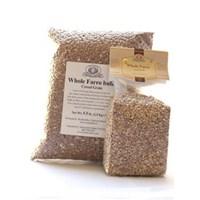Farro is an unhybridized ancestor of modern wheat. It has a hearty, nutty flavor and has been grown throughout Europe for centuries. Today, with renewed interest in traditional and organic foods, farro is featured on the menus of many of the best restaurants in Italy and is rapidly gaining popularity in the United States. Farro is a cereal grain. Unlike wheat, the farro husk adheres to the grain, just as in barley and oats. Its fiber content is therefore high and so are its nutrients. Vitamin E, an antioxidant important to health and disease resistance, is prevalent in farro. Protein content is high also and when combined with legumes, it forms a complete protein source. About 90% of people allergic to hybridized wheat can tolerate farro products. Farro has a different genetic makeup than hybridized wheat and its gluten is more easily digested. However, wheat-allergic people should consult with their physicians before trying farro. Farro thrives on dry and well drained hillsides about 1,000 feet above sea level. Planted in October and harvested in June, farro survives in poor conditions and is best left alone. Although organic methods are used in its minimum cultivation, it is not certified by a third party agency. Farro pasta is made from 100% farro flour. When cooking, remember not to stir during the first minute because farro pasta is more fragile than durum wheat pasta. Rustichella d'Abruzzo's farro is semi-pearled. Appears most often in soups or stews and can be used as a side dish of "farrotto," a recipe that is cooked in the manner of risotto. (source: Manicaretti Imports)


